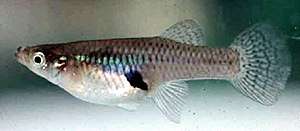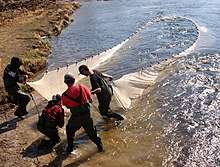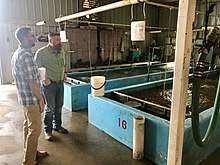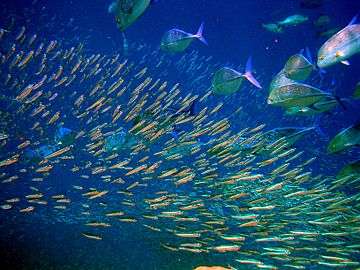Minnow
Minnow is the common name for a number of species of small freshwater fish, belonging to several genera of the family Cyprinidae. They are also known in Ireland as pinkeens.[1]

Smaller fish in the subfamily Leuciscinae are considered by anglers to be "true" minnows [2]
Bluntnose minnow (Pimephales notatus): The bluntnose minnow is a primary bait fish for Northern America, and has a very high tolerance for variable water qualities, which helps its distribution throughout many regions.[3] The snout of the bluntnose minnow overhangs the mouth, giving it the bluntnose. There is a dark lateral line which stretches from the opercle to the base of the tail, where a large black spot is located. The average size of the adult is approximately 5 cm (2 in). 'Pimephales[4]
Common shiner Notropis cornutus: These fish are one of the most common type of bait fish and are almost exclusively stream dwellers. The common shiner can be identified by the nine rays on its anal fin and terminal mouth. This minnow is typically bluish silver on the sides and greenish blue on the back., save for breeding season in which case the male gains a rose colored tail and anal fin. The shiner grows about 5–10 cm (2–4 in) within one year and reach a size of 13 cm (5 in) at adulthood.[5] Another common "shiner" bait fish is the young version of the European chub (Leuciscus cephalus or Squalius cephaloides) which is quite easy to catch. Notropis potteri is known as the chub shiner.
Common emerald shiner (Notropis atherinoides atherinoides): Common shiners are most abundant in the Great Lakes of North America, primarily Lake Erie. The name of the emerald shiner comes from the greenish emerald band that expands from the back of the gill cover to the tail. This type of minnow has a short, rounded snout, the only difference between the common emerald shiner and the silver shiner is that the silver shiner has a longer snout and a larger eye. These fish grow to an average length of about 6 cm. This is one of the most common bait fish used in the Lake Erie region of Ohio and many fisherman hold it over all other bait.[6]
- Cheat minnow, a species in the genus Pararhinichthys
- Cutlips minnow, a species in the genus Exoglossum
- Desert minnows, fishes in the genus Dionda
- Eurasian minnows, fishes in the genus Phoxinus
- Fathead minnow (rosy-red minnow), a species in the genus Pimephales
- Loach minnow, a species of the genus Rhinichthys
- Short levered minnow, a species of the genus Minnellinus
- Pikeminnows, fishes in the genus Ptychocheilus
- Pugnose minnow, a species in the genus Opsopoeodus
- Silverjaw minnow, a species in the genus Notropis
- Longjaw minnow, a species in the genus Ericymba
- Silvery minnows, fishes in the genus Hybognathus
- Suckermouth minnows, fishes in the genus Phenacobius
- Vietnamese cardinal minnow, a species in the genus Tanichthys
- White Cloud Mountain minnow, a species in the genus Tanichthys
Other minnows
Topminnow (Poeciliopsis occidentalis occidentalis): An endangered minnow species which are found primarily in southern New Mexico and Arizona. The drop in the topminnow population can be linked to the introduction of the common mosquitofish. This type of minnow grows to a length of 6 cm (2 1⁄2 in) with the females growing to be larger than the males. During times of breeding males turn black while females and non-breeding males are tan or olive-green. The diet of the topminnow consists of bottom debris, vegetation, and small crustaceans.[7]
Common mosquitofish (Gambusia affinis): The mosquitofish is a very small minnow which has received its name for its fondness for mosquito larvae. The mosquitofish usually reaches a length of only 2.5–5 cm (1–2 in) long. This is a peculiar fish because the male has a "modified" anal fin and female gives birth to live young,[8] much like their related cousins the guppy.

Other fish specifically called minnows include
- in the Southern Hemisphere, some fish in the family Galaxiidae, in particular those of genus Galaxias
- in Southeast Asia, the danionins
- the Drakensberg minnow (Labeobarbus aspius) from the Congo Democratic Republic
- the Maluti minnow (Pseudobarbus quathlambae) from Lesotho
- the Falklands minnow from the Falkland Islands
- the pike topminnow (Belonesox belizanus) are confused for the northern pike, (Esox lucius), also called "minnow" for the little size.
- the minnows of the deep (Cyclothone sp.), small bioluminescent bristlemouth fish approximately 8 centimetres (3 in) long [9]
Catching minnows for bait
Using minnows as baits can be seen by many fishermen as one of the most effective methods for fishing. Bait minnows can usually be found in any bait shop, especially ones near a body of water, but many anglers prefer to capture their own.[10]

Mesh net
A method in which a fisherman finds a school of minnows and using a fine meshnet scoops through the school, bringing the net back out of the water in one motion. This method is primarily used on the shore near the bank of a stream or a shallow area of a lake or pond.[10]
Seine
A seine is a large net, sometimes being 12 metres (39 ft) in size, which has small weights attached to the bottom. These small weights help to keep the net vertical in the water while two people hold either end of the net and drag it through a spot where minnows are suspected to be. This method is good for catching a variety of bait fish and is one of the oldest methods for catching fish.[10]
Wire trap
A wire trap is made of two half-cylinders with concave cones which end in small openings at either end. These two halves are connected together after some sort of bait to entice the minnows has been placed inside. The wire trap is connected to a length of line which is fastened to something on the bank or a float. Minnows are attracted inside the trap by the bait, swimming into the small opening at either end, after they have found their way in it is very difficult for them to escape. This technique is one that requires more time, but less attention.[10]

As food
While primarily used for bait, minnows can also be eaten directly by humans. Some Native American cultures have used minnows as food. [11] If minnows are small enough, they can be eaten whole. [12]
Threats and conservation issues
Minnows are more reproductively resilient than anticipated. Generally, minnows breed with the slightest rainfall and within a wide temperature range. Contrary to the long-standing presumptions, climate change poses 'negligible' threat to minnows' reproduction. Also, they are flexible in attaining pre-spawning fitness, which makes them avoid 'skipped spawning' decisions while facing climatic variabilities.[13]
See also
- Sharks and minnows
- Mudminnows
- Rosy-red minnow
References
- cf. pinkeen and pink, Oxford English Dictionary, Second Edition.Pinkeen Merriam-Webster Dictionary. Retrieved: 2011-12-11.
- "Subfamily Leuciscinae - Hierarchy - The Taxonomicon". taxonomicon.taxonomy.nl. Retrieved 2018-10-02.
- "Pimephales promelas (Black-head minnow)". Animal Diversity Web. Retrieved 2018-10-02.
- Trautman, Milton B. (6 July 1993). "Bluntnose Minnows in Ohio". Department of Natural Resources Ohio Division of Wildlife Document. 189 (R778).
- Trautman, Milton B. (30 June 1993). "Common Shiner in Ohio". Department of Natural Resources, Ohio Division of Wildlife Document. 189 (R778).
- Trautman, Milton B. (30 June 1993). "Common Emerald Shiner in Ohio". Department of Natural Resources, Ohio Division of Wildlife Document. 189 (R778).
- Topminnow Map (Map). 2 June 1983.
- Trautman, Milton B. (6 July 1993). "Mosquitofish in Ohio". Department of Natural Resources, Ohio Division of Wildlife Document. 193 (R778).
- Proujan. C., (1979), SECRETS OF THE SEA, 2ND ED.,London: Reader's Digest Association Limited. Pg.60
- TubeDude. "Minnows" (PDF). "TubeDude". Retrieved 3 April 2012.
- "Minnows | Traditional Animal Foods of Indigenous Peoples of Northern North America - Animals - Fish - Freshwater Fish". traditionalanimalfoods.org.
- https://www.leaf.tv/articles/how-to-cook-minnows/
- Sarkar, Uttam Kumar; Roy, Koushik; Naskar, Malay; Srivastava, Pankaj Kumar; Bose, Arun Kumar; Verma, Vinod Kumar; Gupta, Sandipan; Nandy, Saurav Kumar; Sarkar, Soma Das; Karnatak, Gunjan; Sudheesan, Deepa; Das, Basanta Kumar (March 2019). "Minnows may be more reproductively resilient to climatic variability than anticipated: Synthesis from a reproductive vulnerability assessment of Gangetic pool barbs (Puntius sophore)". Ecological Indicators. doi:10.1016/j.ecolind.2019.03.037.
External links
- . Encyclopædia Britannica. 18 (11th ed.). 1911.

